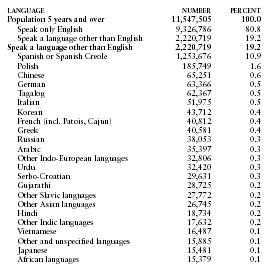Illinois
Languages
A number of place-names—Illinois itself, Chicago, Peoria, Kankakee, and Ottawa—attest to the early presence of various Algonkian-speaking tribes, such as the Kickapoo, Sauk, and Fox, and particularly those of the Illinois Federation, the remnants of which moved west of the Mississippi River after the Black Hawk War of 1832.
Nineteenth-century western migration patterns determined the rather complex distribution of regional language features. Excepting the Chicago metropolitan area and the extreme northwestern corner of Illinois, the northern quarter of the state is dominated by Northern speech. An even greater frequency of Northern features appears in the northeastern quadrant; in this region, speakers get sick to the stomach, catch cold (take cold), use dove as the past tense of dive, pronounce hog, fog, frog, crop, and college with the vowel /ah/, and sound a clear /h/ in whine, wheel, and wheat .
Settlement from Pennsylvania and Ohio led to a mix of Northern and North Midland speech in central Illinois, with such dominating Northern features as white bread, pail, greasy with an /s/ sound, and creek rhyming with stick . Here appear Midland fishworm (earthworm), firebug (firefly), wait on (wait for), dived as the past tense of dive , quarter til four (3:45), and sick at one's stomach (but sick on the stomach in German communities near East St. Louis).
Migration from South Midland areas in Indiana and Kentucky affected basic speech in the southern third of Illinois, known as Egypt. Here especially occur South Midland and Southern pullybone (wishbone), dog irons (andirons), light bread (white bread), and, in extreme southern countries, loaf bread, snakedoctor (dragonfly), redworm (earthworm), ground squirrel (chipmunk), plum peach (clingstone peach), to have a crow to pick (to have a bone to pick) with someone, and the pronunciations of coop with the vowel of put and of greasy with a /z/ sound. Such speech is found also in the northwestern corner around Galena, where Kentucky miners who came to work in the lead mines brought such pronunciations as bulge with the vowel of put, soot with the vowel of but, and /yelk/ for yolk .
Metropolitan Chicago has experienced such complex inmigration that, although it still has a basic Northern/Midland mix, elements of almost all varieties of English appear somewhere. The influx since World War II of speakers of black English, a Southern dialect, and of nonstandard Appalachian English has aggravated language problems in the schools. Foreign-language schools were common in the 1880s and 1890s, but by 1920 all instruction was in English. The policy of monolingual education came into question in the 1970s, when the state legislature mandated bilingual classes for immigrant children, especially Spanish speakers.
In Chicago, rough-and-tumble politics has created a new meaning for clout; prairie means a vacant lot, porch includes the meaning of stoop, and cornbread has been generalized to include the meanings of corn pone and hush puppies . A fuel and food stop on the Illinois tollway system is an oasis .
In 2000, English was spoken at home by 80.8% of all state residents five years of age and older, down from 85.8% in 1990.
The following table gives selected statistics from the 2000 census for language spoken at home by persons five years old and over. The category "Other Indo-European languages" includes Albanian, Gaelic, Lithuanian, and Rumanian. The category "Other Slavic languages" includes Czech, Slovak, and Ukrainian. The category "Other Asian languages" includes Dravidian languages, Malayalam, Telugu, Tamil, and Turkish. The category "Other Indic languages" includes Bengali, Marathi, Punjabi, and Romany.

| LANGUAGE | NUMBER | PERCENT |
| Population 5 years and over | 11,547,505 | 100.0 |
| Speak only English | 9,326,786 | 80.8 |
| Speak a language other than English | 2,220,719 | 19.2 |
| Speak a language other than English | 2,220,719 | 19.2 |
| Spanish or Spanish Creole | 1,253,676 | 10.9 |
| Polish | 185,749 | 1.6 |
| Chinese | 65,251 | 0.6 |
| German | 63,366 | 0.5 |
| Tagalog | 62,367 | 0.5 |
| Italian | 51,975 | 0.5 |
| Korean | 43,712 | 0.4 |
| French (incl. Patois, Cajun) | 40,812 | 0.4 |
| Greek | 40,581 | 0.4 |
| Russian | 38,053 | 0.3 |
| Arabic | 35,397 | 0.3 |
| Other Indo-European languages | 32,806 | 0.3 |
| Urdu | 32,420 | 0.3 |
| Serbo-Croatian | 29,631 | 0.3 |
| Gujarathi | 28,725 | 0.2 |
| Other Slavic languages | 27,772 | 0.2 |
| Other Asian languages | 26,745 | 0.2 |
| Hindi | 18,734 | 0.2 |
| Other Indic languages | 17,632 | 0.2 |
| Vietnamese | 16,487 | 0.1 |
| Other and unspecified languages | 15,885 | 0.1 |
| Japanese | 15,481 | 0.1 |
| African languages | 15,379 | 0.1 |